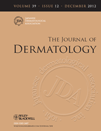Evaluation of effectiveness of erbium:yttrium–aluminum–garnet laser on atrophic facial acne scars with 22-MHz digital ultrasonography in a Turkish population
ABSTRACT
Scar formation due to acne is a common problem among the young population and significantly affects their quality of life. The aim of this study was to evaluate the efficacy of erbium:yttrium–aluminum–garnet (Er:YAG) laser resurfacing for acne scars and to objectively demonstrate the altering of collagen density in the dermis by 22-MHz digital ultrasonography. Twenty-one patients, aged 19–55 years, with facial acne scars were treated with Er:YAG laser. The results of the laser resurfacing were evaluated for the degree of clinical improvement, alteration of the collagen density by 22-MHz digital ultrasonography and any adverse effects at 3 months. At 3 months after the treatment, good (in 12 patients) and near total (in four patients) clinical improvement was noted in most of the patients compared to baseline. Overall treatment results were 76% (both near total and good) in 16 patients. By ultrasonographic evaluation, the average density of dermal collagen (total density/number of patients) of 21 patients was 32.714 (right cheek) and 32.142 (left cheek) before laser facial resurfacing. At the third month after treatment, the average density of dermal collagen of 21 patients was 36.380 (right cheek) and 38.809 (left cheek). In conclusion, Er:YAG laser skin resurfacing was found to be a safe and effective treatment modality for treatment of atrophic facial acne scars. As public demand grows for less invasive modalities to approach clinical diagnosis and evaluation, digital ultrasonography seems to provide an easy and confidential method for collagen density evaluation.




